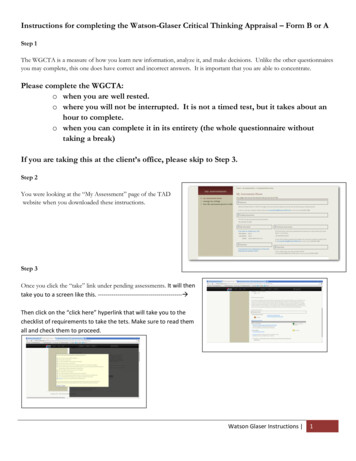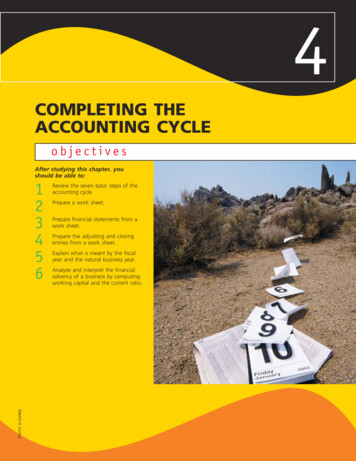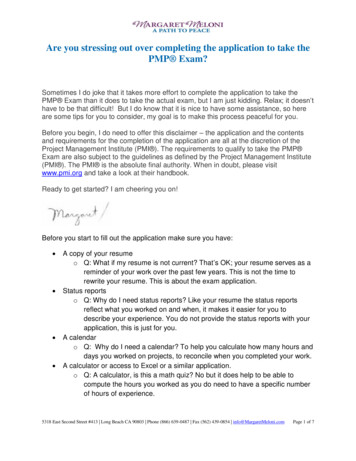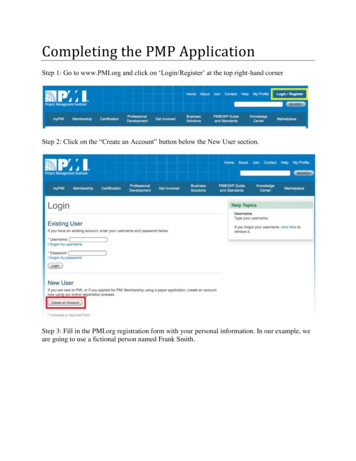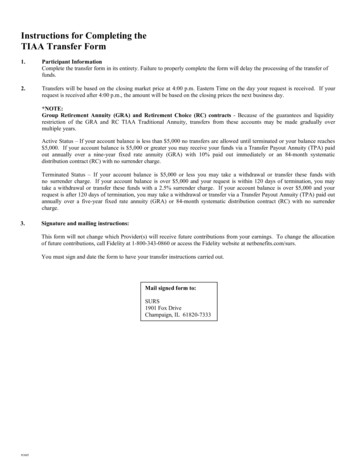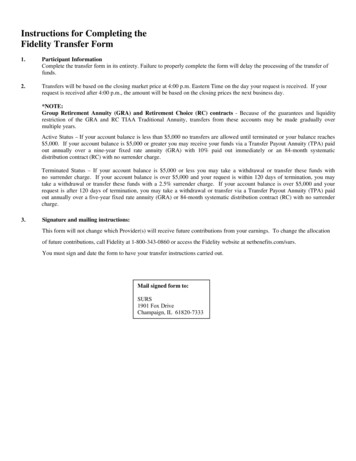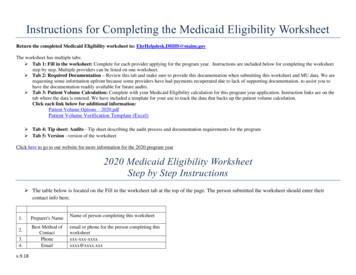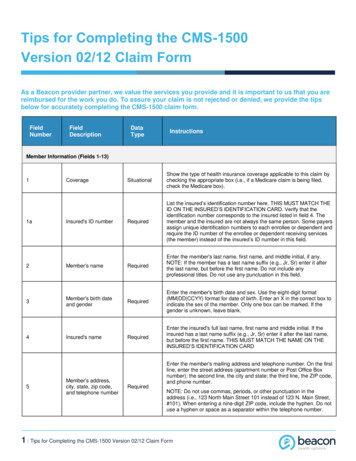
Transcription
Sacramento County Public Law Library& Civil Self Help Center609 9th St.Sacramento, CA 95814(916) 874-6012saclaw.org Home Law 101COMPLETING AND RECORDING DEEDSAdding or Changing Names on PropertyThis Guide includes instructions and sample forms. Copies of this Guide and related forms may bedownloaded from: saclaw.org/recording-deedsBACKGROUNDAny time owners make a change to the title of real estate, they mustrecord a deed with the County Recorder. This Step-by-Step guideoutlines the requirements and provides samples with instructions.Transfers after DeathCalifornia mainly uses two types of deeds: the “grant deed” and the“quitclaim deed.” Most other deeds you will see, such as the common“interspousal transfer deed,” are versions of grant or quitclaim deedscustomized for specific circumstances. Since the interspousal deed isso commonly requested, we are including a sample in this guide.This guide does not coverchanges due to the deathof a property owner. Youwill need either an Affidavitof Death or a probate orderin such cases.A grant deed is used when a person who is on the current deedtransfers ownership or adds a name to a deed. The grantor(s)promise that they currently own the property and that there are no hidden liens or mortgages.A quitclaim deed (sometimes misspelled “quick claim”) is used when someone gives up (waives ordisclaims) ownership rights in favor of another person. The grantor may or may not be on the currentdeed. A quitclaim deed is often used in divorces or inheritance situations, when a spouse or heirgives up any potential rights to real estate. The grantor is giving up their own rights, if any, but notpromising anything else.An interspousal deed is used between spouses or registered domestic partners (“DP”) to changereal estate to or from community property. Spouses/DPs can use grant or quitclaim deeds to do thesame things, but the interspousal deed makes it clear that the transaction is intended to affectcommunity property rights.Warning about adding namesIf you add a name or sign a quitclaim deed, the grantee becomes an owner. You can’tchange your mind without their signature.If you are adding them as part of a credit repair or loan deal, it may be a scam.If you are adding an heir, a living trust or Transfer on Death Deed lets you name them toinherit without giving up control.Disclaimer: This Guide is intended as general information only. Your case may have factors requiringdifferent procedures or forms. The information and instructions are provided for use in theSacramento County Superior Court. Please keep in mind that each court may have differentrequirements. If you need further assistance consult a lawyer.
saclaw.orgCompleting and Recording Deeds Home Law 101STEP BY STEP INSTRUCTIONSStep 1: Locate the Current Deed for the PropertyYou will need information from the current deed. If you need a copy of the current deed, contact theRecorder’s Office where the property is located. In Sacramento, call (916) 874-6334.Step 2: Determine What Type of Deed to Fill Out for Your SituationTo transfer ownership, disclaim ownership, or add someone to title, you will choose between a “grantdeed” and a “quitclaim deed.” Spouses/domestic partners transferring property between each othermay choose an “interspousal deed.” Blank deeds are available at saclaw.org/forms.The deed I need is not on your list! Warranty, joint tenancy, easement, etc.In a warranty deed, the grantor promises to pay for any lawsuits or damages due to undisclosed ownershipdisputes. In California, title insurance usually covers such disputes.Other types of deeds, such as joint tenancy deeds, corporation deeds, easement deeds, or mineral rights2deeds, are usually customized grant deeds. You can customize our grant deed format for most of them.Consultan attorney or come to the Law Library to research appropriate wording.saclaw.org/recording-deeds
saclaw.orgCompleting and Recording Deeds Home Law 101Step 3: Determine How New Owners Will Take TitleOne, unmarried owner: leave blankIf there is only one new owner, and that person is unmarried, title can usually be left blank, although itdoesn’t hurt to state “a single person” or “a widow” or the like.If there is more than one new owner, you are moving the real estate into or out of a trust, or the newowner is married, the form of title can have important effects.More than one owner: owners are not a married couple or registered domestic partners (DP).Ex.: relatives who inherit property together, business partners,couples who are not married/DP.But I’m Not a Tenant! “Tenants in common” (When one dies, their heirs get theirshare; probate may be needed. Shares do not need to beequal. Any owner can sell or mortgage their portion.)“Joint tenants” (When one dies, the other gets 100%automatically. Shares must be equal. Any owner can sell ormortgage their portion.)If you leave this blank, the default is “tenants in common.”“Tenant in common” and“joint tenant” are just oldfashioned phrases thatlawyers still use. In thiscontext they refer to theowners.For married couples and registered domestic partners, if both own the property, the choices are “Community property” (Both must agree to sell or mortgage. At death, 50% to survivingspouse/DP, 50% to heirs)“Community property with rights of survivorship (WROS)” (Both must agree to sell ormortgage. At death, 100% to surviving spouse/DP.)“Joint tenants” (When one dies, the other gets 100%. Shares must be equal. Either spouse/DPcan sell their portion. May receive less favorable tax treatment when first spouse/DP dies.)If you leave this blank, the default is “community property.”There are more advantages and disadvantages to each form of title. Your choice of title can havemany effects later, such as when you sell, when one spouse/DP passes away, or if you divorce,including: higher property taxeshigher capital gains taxeshow the property would be divided in a divorcewhether the property can be seized or liened for one spouse/DP’s separate debts.If you have questions about which form of title to use, talk to a family or estate lawyer or researchyour options at the law library.If only one spouse/DP owns the property (because that person already owned it when they gotmarried or it was a gift or inheritance), they can make that clear by using the phrase “as his or hersole and separate property.” Note that if any money earned during the marriage is spent to purchase,make mortgage payments, maintain, or improve the house, the community owns a share regardlessof what it says on the deed.3saclaw.org/recording-deeds
saclaw.orgCompleting and Recording Deeds Home Law 1014saclaw.org/recording-deeds
saclaw.orgCompleting and Recording Deeds Home Law 101Step 4: Fill Out the New Deed (Do Not Sign)Filled-out samples of each type of deed are attached at the end of this guide.The deed should be filled out online, typed, or neatly written in dark blue or black ink. You will needthe following information:Assessor’s Parcel Number.Document Transfer Tax amount or exemption code.Names of “grantors” (the current owner(s) signing the deed) or of the disclaiming party(ies).Names of “grantees” (all new and continuing owners).I don’t want this personImportant: If you add a name, that person legally becomes anto be an owner! I justowner. You cannot change your mind without their signature.want them to inherit my Form of title the grantees will use (for grant and interspousalhome, or help theirdeeds).credit rating, or help The legal description of the property.my credit rating, or.Here are some common issues while filling out deeds.Adding a person’s nameDocumentary Transfer Taxcan lead to tax issues, liensWhen property changes hands, the county charges a one-time taxon the property for theirof .55 per 500 of the value of the real estate (1.1%). Some kindsdebts, disputes and delaysof transfers are exempt. If yours is exempt, enter the Revenue andif one owner wants to sellTaxation code that provides the exemption, and an explanation,or mortgage the property,then sign. If yours is not exempt, calculate the dollar amount andand more.write it in.If you are trying to avoidCommon exemption codes and explanations:probate, you may want tolook into a living trust or a Gift (transferring property, or adding name to property,Transfer on Death (TOD)without compensation):Deed. See our TOD DeedCode: “R&T 11911” Explanation: “Gift.”guide for more info about Living Trust (transfer into or out of revocable living trust):that option.Code: “R&T 11930” Explanation: “Transfer into or out of atrust” Name Change (confirming name change after marriage or court-ordered name change):Code: “R&T 11925” Explanation: “Confirming change of name, the grantor and grantee are thesame party.” Conveyances in dissolution of marriage:Code: “R&T 11927” Explanation: “Dissolution of marriage.” Other exemptions are available. See the list of “Transfer Tax Exemptions” on the SacramentoRecorder’s website at ons.pdf.Note: as of January, 2018, there is an additional 75 fee on mortgage refinances and other realestate transactions that are exempt from Documentary Transfer Tax. Some exceptions apply.Contact your county recorder’s office to determine the total amount you will need to pay.5saclaw.org/recording-deeds
saclaw.orgCompleting and Recording Deeds Home Law 101Identifying grantors and granteesUpdating deeds afterGrantor(s): The current owner or persona name changetransferring the property rights or part of theIf you change your name, deeds made out to yourproperty rights. This is the person or peopleold name should be updated. Record a grant deedwho will sign this deed.as follows:Grantee(s): List all people who arereceiving property rights from the[New Name], formerly known as [Old Name],grantor(s). If the grantor is staying on title,hereby grants to [New Name]be sure to list the grantor’s name as one ofEx: Chris Moore changes his name to Chris Jones:the grantees also.It’s often helpful to include the grantors’ andgrantees’ marital status.Here are common ways to identifygrantor(s)/grantee(s):Unmarried person or people:[Name(s)], or [Name], an unmarried (orsingle) man/woman/personEx: Jeffery Marcus Kim, Paul George Kim, and Helen Mary Lee orJill Pham, a single personCouple who are married or registered domestic partners (DP):[Name 1] and [Name 2], a married couple or husband and wife or [Name 1] and [Name 2], registereddomestic partnersEx: Pat Orr and Ann Orr, husband and wife orJames Robert Smith and Geoffrey Laber, registered domestic partnersOne person, who is married or a DP, but signing deed or taking title without spouse/DP:[Name], a married man/woman/person or a registered domestic partnerEx: Ann Orr, a married woman orGeoffrey Laber, a registered domestic partnerTrustee:[Name of trustee] as trustee of the [name and date of trust as written in trust documents]Ex: Art Li Jr., as trustee of the Arthur Li Senior and June Li Family Trust dated May 1, 2012Partnership:[Name on file as fictitious business name, if any] or [names of partners], a partnershipEx: Elm Street Books, a partnership orJanet Smith and Mark Baker, a partnershipCorporation or LLC:[Name of corporation], a [state of incorporation] corporation or[Name of LLC], a [state of registration] limited liability companyEx: Acme, Inc., a California corporation orAcme, LLC, a California Limited Liability Company6saclaw.org/recording-deeds
saclaw.orgCompleting and Recording Deeds Home Law 101Forms of Title for Multiple OwnersWhen there is more than new one owner, you will need to specify the form of title. It’s also helpful ifthe new owner is a married person or domestic partner. (See Step 3 for more information about thedifferent forms of title.) Here are examples using common title phrases: as tenants in common (default for unmarried owners, will be used if line is blank)as joint tenantsas community property (default for married/DP owners, will be used if line is blank)as community property with right of survivorshipas separate, not community property or as sole and separate property (separate propertyowned by one spouse/DP).Here are some examples of wording:No form of title for one ownerJoint tenants selling to a married woman,who will own it as separate propertySingle woman selling to a married couple, who will ownit as community property WROSDistributing property from a trust to the heirs, who canreceive unequal shares as tenants in commonLegal DescriptionThis is the full description of the property, not just the address. It may be brief or very long and full oflegalese. It must match the current deed exactly. You may want to photocopy it and attach it to thenew deed as an exhibit, especially if it is too long to fit on the page.7saclaw.org/recording-deeds
saclaw.orgCompleting and Recording Deeds Home Law 101Step 5: Grantor(s) Sign in Front of a NotaryThe grantees do not need to sign. The notary will charge a fee for this service. You can find notariesat many banks, mailing services, and title companies.Step 6: Fill Out the Preliminary Change of Ownership Report (PCOR)The PCOR is required when property changes hands, to update the tax records. Turn it in at theRecorder’s Office along with the deed. You can download a Sacramento version of the PCOR E-502-A/. Each county has its own version;contact the assessor’s office in the county where the property is located to obtain the proper form.Step 7: Record the Deed and File the PCOR at the Recorder’s OfficeThe Recorder’s Office charges a recording fee (currently 21/first page plus 3 for additional pages).Current Sacramento fees are available at the County Clerk/Recorder’s website atwww.ccr.saccounty.net/Pages/Fees.aspx.Step 8: File Reassessment Exclusion Claim, if any, at the Assessor’s OfficeWhen property changes hands, it is reassessed for tax purposes, often causing a sizeable increase inproperty tax for the new owner.Certain transfers are excluded from reassessment, including: Parent to child or child to parent (“Prop 58” exclusion)Grandparent to grandchild (but not vice versa)Transfers between spouses or registered domestic partners during marriage or as part of aproperty settlement or divorceChanges in method of holding title that do not change ownership interests (for instance,changing joint tenants into tenants in common)If your transfer is excluded from reassessment, you may need to file a claim with the CountyAssessor. For more information in Sacramento, call the Assessor’s office (916-875-0750) or visit theSacramento Assessor’s office website at www.assessor.saccounty.net.FOR HELPSenior Legal HotlineToll Free: (800) 222-1753; Sacramento County: (916) 551-2140www.seniorlegalhotline.org/Free legal assistance for Sacramento residents age 60 and over on almost any civil issue, includingproperty transfers and deeds.Voluntary Legal Services ProgramEstate Planning for Low Income Individuals(916) 551-2106VLSP offers assistance with basic estate planning, including living trusts which can be used to transferreal estate without probate.8saclaw.org/recording-deeds
saclaw.orgCompleting and Recording Deeds Home Law 101FOR MORE INFORMATIONOn the Web:Sacramento County Clerk-Recorder’s Officewww.ccr.saccounty.net/Sacramento County Assessor’s ousal Transfers vs Quitclaim Deed”Self-help information about the differences between these two deeds.At the Law Library:Deeds for California Real Estate KFC 170 .Z9 R36This book, published by Nolo Press, a respected publisher of self-help legal books, is a guide tochoosing the right kind of deed, completing the required forms, and filing them. It also discussesrelated legal issues such as disclosure requirements, community property issues, and tax and estateplanning. It contains forms for most transfers of property.Electronic Access: From any computer (Law Library or home) via the Legal Information ReferenceCenter. Instructions are available on our website at saclaw.org/nolo-ebooks.Miller & Starr California Real Estate Forms KFC 140 .M53Sections 1:133-1:137 offer language for grant, interspousal, quitclaim, and easement deeds.Electronic Access: From Law Library, on Westlaw.California Real Property Practice Forms Manual KFC140.A65 C34A range of sample forms for specific situations such as easements, mineral rights, and more.IF YOU HAVE QUESTIONS ABOUT THIS GUIDE, OR IF YOU NEED HELP FINDING OR USING THEMATERIALS LISTED, DON’T HESITATE TO ASK A REFERENCE deedsRevised 8/17 kf
saclaw.orgCompleting and Recording Deeds Home Law 101ATTACHMENTS: FORMS AND INSTRUCTIONSDeeds must be in a format that the Sacramento County Clerk/Recorder’s Office will accept.Customizable templates may be downloaded from these links: Grant rtfQuitclaim tclaim-deed.rtfInterspousal l-grant-deed.rtfSample filled-in forms with instructions are attached on the following pages.You will also need: PCOR (Preliminary Change of Ownership rm/BOE-502-A/Download the PCOR from this link or obtain it from the county assessor (they are different in eachcounty). A sample filled-in Sacramento PCOR with instructions f) is available on our website.You may also need reassessment exclusion forms from the assessor’s office.Check with your local assessor’s office to determine if you need to file exclusions from reassessmentand if so what forms are required. In Sacramento, you can find out about reassessment exclusionsand download forms on the Sacramento County Assessor’s website at: Change in Ownership Reassessment Exclusions Including Transfers Between /recording-deeds
saclaw.orgCompleting and Recording Deeds Home Law 101Sample Grant Deed with InstructionsRecording requested by (name):[Name(s) of new owner(s)]And when recorded, mail this deed and taxstatements to (name and address):Documentary Transfer Tax: Line 1: enter the amount of Doc. Transfer Tax due, or 0 if exempt. Line 2: If you are paying 0, put the Cal. Rev. & Tax code exempting youin the 2nd line. Otherwise leave blank. Line 3-4: If you are paying 0, explain why. Otherwise leave blank. Signature: You (or your agent if any) sign the last line.[Name(s) of new owner(s)][Mailing address of new owner(s)][Mailing Address City, State, ZIP]Find this on thecurrent deed.GRANT DEEDAssessor’s Parcel No. (APN):[Assessor’s Parcel Number]Documentary Transfer Tax: [1]If exempt, enter R&T code: [2]Explanation: [3][4]SignatureSignature of Declarant or Agent determining taxGov’t Code § 27388.1 (SB 2) FeeDocuments that do not pay Documentary TransferTax pay a 75 SB2 fee. Leave this box blankunless you qualify for an exemption.Declaration of Exemption From Gov’t Code § 27388.1 FeeTransfer is exempt from fee per GC § 27388.1(a)(2):recorded concurrently “in connection with” transfer subject toDocumentary Transfer Taxrecorded concurrently “in connection with” a transfer ofresidential dwelling to an owner-occupierTransfer is exempt from fee per GC 27388.1(a)(1):Fee cap of 225.00 reachedNot related to real propertyFor a valuable consideration, receipt of which is hereby acknowledged,Examples:GRANTOR(S) [Name(s) of owner(s) signing deed],(Owner(s) who are signing deed)[form of title if needed] .Mary Campbell and John Walsh,tenants in common Than Nguyen, an unmarried woman ] Bob Roberts, as trustee of theRoberts Family Trust dated Jan. 1,hereby grant(s) to GRANTEE(S) [New owner(s). Include curren
Acme, LLC, a California Limited Liability Company. Updating deeds after a name change . If you change your name, deeds made out to your old name should be updated. Record a grant deed as follows: [New Name], formerly known as [Old Name], her


